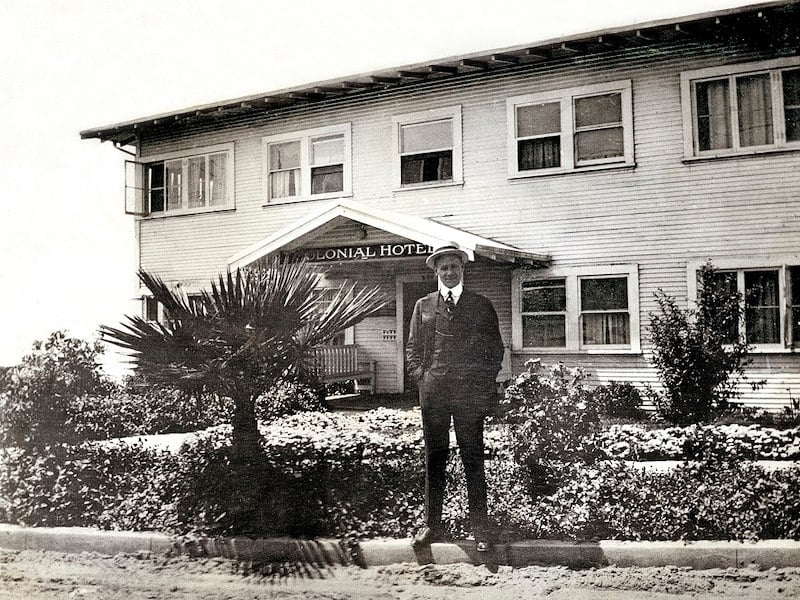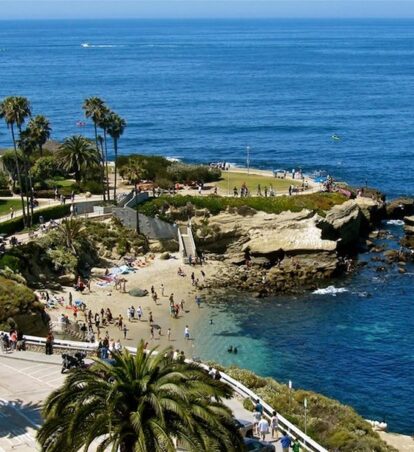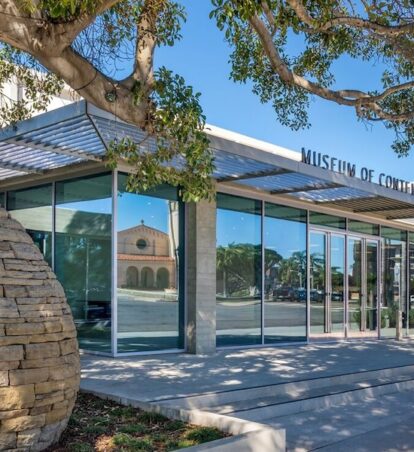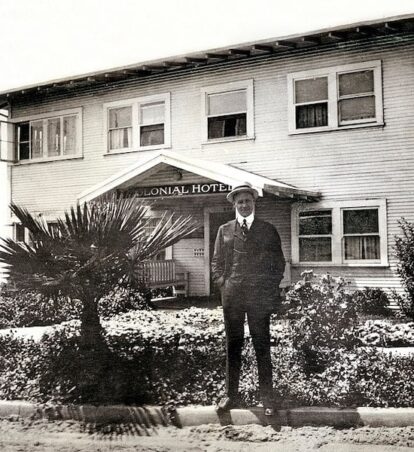Grande Colonial La Jolla: A Community's Historical Landmark
In the early twentieth century, La Jolla, like mostly everywhere in the country, was growing fast. Considered by most to be a small artist colony without paved streets or home addresses, the town's population grew from 300 people in 1900 to more than 2,000 by 1920. Tourism was quickly becoming the economic base of the community and so set the stage for the emergence of what would become one of La Jolla's most loved landmarks of the past: the Grande Colonial.
Listed on The Registry of Historic Hotels of America, the Grande Colonial is La Jolla's oldest operating hotel. One hundred years ago it was a bit smaller and perhaps less formal, but just like La Jolla, the Grande Colonial grew in size and stature over the years. It is now an elegant and lively seaside hotel with a style all its own.
The hotel's story begins in 1913. Woodrow Wilson was America's new President, federal income tax began, the zipper was invented, and Cracker Jacks started coming with a prize in every box. Locally, horses and cars were still sharing an unpaved and windswept dirt road called Prospect Street. Women were strolling this and other streets in dresses that showed off…their ankles!
La Jolla was becoming an increasingly popular seaside destination and real estate partners A.B. Harlan and George Bane thought the time had come to build an informal, first-class beach hotel to offer year-round lodging. Harlan and Bane bought an ideal location overlooking the ocean on one side and the village shops on the other. The up-and-coming local architect, Richard Requa, was hired to design a hotel that included complete apartments and single guest rooms. At the time, it was common to offer both accommodations as travelers often requested long stays.
Requa's design included two structures in the popular Prairie Style, which gracefully fit in with the many bungalows that defined the village's architectural character. There were large overhangs, exposed rafters, an emphasis on horizontal lines, and a large common fireplace where visitors could gather and share the day's stories. The hotel was described as "a perfectly-appointed apartment hotel with the finest sun parlor and lobby over- looking the ocean on the Pacific Coast." Rooms cost $1 per night, and it boasted private baths, steam heat, electric lights, long distance telephone service and the best furnishings of any apartment in San Diego.
Harlan and Bane named their new establishment The Colonial Hotel and Apartments. They managed the hotel themselves from their office next door that also served as the front desk. The small community happily embraced the new hotel. Requa eventually became famous for designing The Del Mar Castle and was the master architect of the California Exposition in Balboa Park.
The Colonial was exceptionally well suited to the time and place, but soon there was more demand than supply. By 1925, Bane had bought out Harlan and began thinking bigger would be better. He wanted a grand hotel that was in keeping with La Jolla's growth as an upscale beach community. This time Bane hired Frank Stevenson—a local architect known for his large civic structures—to design a hotel that "would rival anything in the west."
Construction soon began, but building a new five-story, fireproof structure was not easy. The plan called for the original front building to be picked up and relocated on a slope around the corner.
In time, this challenge and others were met, and the hotel was completed in 1928. It was indeed impressive, touting central heating, apartments with refrigerators (un-stocked), and the first fire sprinkler system west of the Mississippi. The rooms and public spaces were "artistically appointed," the walls were shades of cream with rose and green accents and a variety of lush carpets and drapes. The furniture was period mahogany; black marble trimmed fireplaces, ornate crystal chandeliers, beautifully lit through large leaded-glass windows and French doors completed the impressive design.
Room rates for the new hotel were $3.00 to $6.00 per night and included golf privileges at the new La Jolla Country Club. Opening night was a gala social affair with a harp and violins playing period music in the lobby while Bane and his wife gave tours of the rooms. He said the new hotel was "…the concrete expression of my faith" that La Jolla would become a premier destination.
"La Jolla is a little old town unto its own. Its future, I think, is already won and the new Colonial will be in time for the show" he expressed to his new manager. The new Colonial appealed to more than just beach-going travelers, it also delighted locals by incorporating Putnam's, the popular pharmacy and soda fountain next door.
Like everywhere else, the depression of the 1930's was a hardship on people in La Jolla, but WW II brought the military and prosperity to San Diego. The Colonial became popular housing for officers from nearby Camp Callan, an Army base with a long-range gunnery school on land that is now Torrey Pines Golf Course and the campus of the University of California, San Diego. Many officers stayed at the hotel with their wives, many of whom split their time between volunteering for the Red Cross and enjoying the beach. The hotel's Sun Parlor was partitioned off at night for single soldiers. One has to assume they made the most of the "inconvenience" of having to live off base.
After WWII, happier days returned, and La Jolla regained its cache as an upscale vacation spot. The La Jolla Playhouse was established, and the hotel was popular with famous actors, artists, and celebrities who were writing, painting, performing, having a tryst, or simply getting a reprieve from the pressures of Hollywood.
The good times rolled through the ‘50's, mellowed out in the ‘60's, and by 1976 the Colonial needed and got a major renovation. The new owners paid $1 million for the hotel, spent another $3 million restoring it, and then graced it with the name, The Colonial Inn. The project was popular with locals who favored controlled growth. The new owners were so successful in reviving the hotel's charm that it received the "People in Preservation" Award. The award said "The Colonial Inn…brings the very best of La Jolla's past tastefully into the present. Elegance, continental service, graceful design, and décor, all embraced in the ambience of a small European Hotel." George Bane couldn't have said it better.
By the turn of the 21st century, the Colonial was ready for more renovation and another new name, the Grande Colonial. Over the next decade, another $13 million was invested to bring it current in aesthetics, technology, and energy usage. Most notable of the new work was the purchase of two adjacent historic properties – the Garden Terraces and the Little Hotel by the Sea, the latter which over the years was also called "La Posada" and "The Heidi House."
These two buildings, celebrating a rich history all their own, are the last of the areas original small inns and have been designated La Jolla historic sites. Their preservation as extended-stay accommodations under the Grande Colonial name preserved the neighborhood's character while providing more guests the opportunity to stay in traditional beach suites that are a home away from home with full kitchens and fireplaces. Frequent long time guest Hal Schwarz said of the rooms, "you don't feel as if you're in a hotel"
All this dedication has paid off handsomely. With all its historic grandeur completely restored The Grande Colonial has an AAA Four Diamond rating. Attention is given to every detail in the rooms and the service to keep it this way, from the fine lobby furnishings to the quality of the linens in every room. The current owners and management will continue the Colonial's distinguished tradition with the objective of making it one of the most elegant boutique hotels in California. The Grande Colonial wants to be sure it's serving guests for the next 100 years, and with its romantic ocean views, crackling fire, elegant interiors, sumptuous cuisine, and impeccable service, many more guests will become firm believers.






